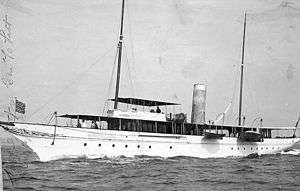USS Felicia (SP-642)
 Felicia underway prior to World War I. | |
| History | |
|---|---|
| Name: | USS Felicia |
| Namesake: | Former name retained |
| Owner: | Jesse H. Metcalf of Providence, Rhode Island |
| Builder: | J. N. Robbins Company, of Brooklyn, New York |
| Laid down: | date unknown |
| Launched: | 1898 |
| Christened: | as Felicia |
| Completed: | 1898 |
| Acquired: | 21 June 1917 |
| Commissioned: | 29 June 1917 as USS Felicia (SP-642) |
| Decommissioned: | 25 August 1919 at Brooklyn, New York |
| Struck: | September 1919 |
| Homeport: | Newport, Rhode Island |
| Fate: | sold 25 March 1920 |
| General characteristics | |
| Type: | Yacht |
| Tonnage: | 213 gross tons |
| Length: | 179' |
| Beam: | 20' 1" |
| Draft: | 7' 6" |
| Propulsion: | Steam engine |
| Speed: | 14 knots |
| Complement: | 49 officers and enlisted |
| Armament: | Three 3-pounder guns |
USS Felicia (SP-642) was a yacht acquired by the U.S. Navy during World War I. She was outfitted and armed by the Navy as a patrol craft, and was assigned to patrol the New England waters. Her task of protecting ships from German submarines was interrupted by her collision with a submarine. Post-war she was reconfigured to her civilian condition, and was sold in 1919.
Built as a yacht in Brooklyn
The first ship to be so named by the Navy, Felicia (No. 642) was built in 1898 by J. N. Robins Company, Brooklyn, New York; purchased by the Navy 2 June 1917; and commissioned 29 June 1917, Lieutenant H. Langworthy, USNRF, in command. (The other USS Felicia, PYc-35, was built in 1931, and served in World War II.)
World War I service
Based out of Newport, Rhode Island, Felicia patrolled the New England coast, on duty with the 2d Naval District, until August 39, 1918, when she collided with a submarine in heavy fog off Montauk Point.
Decommissioning and sale
Felicia was in repair or laid up at various yards until decommissioned at Brooklyn, New York, 25 August 1919. Felicia was stricken from the list of Naval vessels in September 1919 and sold 25 March 1920.
See also
References
- This article incorporates text from the public domain Dictionary of American Naval Fighting Ships. The entry can be found here.
- Felicia (American Steam Yacht, 1898). Served as USS Felicia (SP-642) in 1917-1920